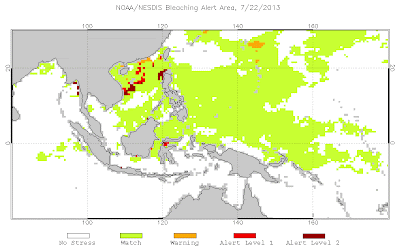We also hopped over to nearby Terumbu Pempang Laut to look for Giant clams. I also took the opportunity to check for coral bleaching in the two submerged reefs.
Here's a closer look at the magnificently huge Fluted giant clam (Tridacna squamosa) that I found in Apr 2013. Mei Lin (aka Giant Clam Girl) is studying them so as to better protect these amazing animals in Singapore and beyond. Kareen and Mei Lin think this enormous Giant clam might be as old as I am: 40-50 years. Imagine that this clam started life when I was born! The team also went to check up on the smaller giant clams we saw on this shore in Apr 2012.
Another treat for the day was to see a Yellow-lipped sea krait (Laticauda colubrina). It has a paddle-shaped tail, and from its face we can see how it got its common name. Its eyes seem opaque, perhaps it's getting ready to moult?
There are large clumps of Magnificent anemone (Heteractis magnifica) here. The anemones may seen oddly coloured but this is the colour they've been when I saw them on past trips.
I managed to get a glimpse of two shy False clown anemonefish (Amphiprion ocellaris) in one of the anemones.
Another sea anemone had a pair of anemone shrimps (Periclimenes brevicarpalis). We also saw Blue-spotted fantail rays (Taeniura lymma) when we landed. The only nudibranch I saw was one Glossodoris atromarginata and Bill spotted an octopus. But I didn't focus much on spotting other marine life as I was desperately hunting for clams!
There were many hard corals on the shore in dispersed clumps. Some of the colonies were large (more than 50cm in diameter), most of these were Pore hard corals (Porites sp.). Those I saw seemed alright without any signs of bleaching.
I saw a few colonies of Crinkled sandpaper coral (Psammocora sp.), Cauliflower coral (Pocillopora sp.) and Acropora coral (Acropora sp.). None of them were bleaching. These kinds of corals were among the first to bleach during the 2010 global mass bleaching event.
I saw several Anemone corals (Goniopora sp.) that were pale, but most were the normal purplish or brown colour.
As usual, Favid corals (Family Faviidae) are the most abundant kind of coral on the shore. All of those I saw seemed alright.
Except for two colonies that were partially bleaching. I also saw one leathery soft coral (Family Alcyoniidae) that was in full bleach.
I saw many different kinds of leathery soft corals (Family Alcyoniidae) and most seemed alright.
All the Asparagus flowery soft corals (Family Nephtheidae) I came across were rather pale with yellowish tips.
There is a bloom of Bryopsis seaweed (Bryopsis sp.) on the shore.
I came across patchy sparse growths of Tape seagrass (Enhalus acoroides), some were cropped short, while others were somewhat longer. There were scattered clusters of Spoon seagrasses (Halophila ovalis) and Sickle seagrass (Thalassia hemprichii) on this reef.
We then hopped over to Terumbu Pempang Laut. Most of the soft and hard corals there seemed alright.
Ambert found a new Giant clam! It's a cute little one. But we failed to find the other one we saw here in May 2012.
I came across this cluster of leathery soft corals (Family Alcyoniidae) have bleaching portions. While making the landing, I also saw a few coral colonies in deeper water that were bleaching.
I saw many different kinds of leathery soft corals (Family Alcyoniidae) and most seemed alright, or showed only some slight bleaching.
During the short 20 minute stop, most of the Favid corals (Family Faviidae) looked alright and so did the Cauliflower coral (Pocillopora sp.) and Galaxy coral (Galaxea sp.) that I saw.
There were very green growths of Spoon seagrasses (Halophila ovalis) and Sickle seagrass (Thalassia hemprichii) on this reef. Although one of the leaf blades I looked at seemed to have a serrated edge, looking at the photo, these turned out to be dark marks on the leaf edge.
There were scattered clumps of Tape seagrass (Enhalus acoroides) and some had long leaf blades while others had shorter blades.
The bleaching at Terumbu Pempang Tengah and Terumbu Pempang Laut did not seem as bad as the bleaching we saw at Terumbu Hantu on 28 Jun 2013. Although according to NOAA’s Coral Reef Watch which gives predictions of global coral bleaching, the global situation seems to have worsened in July compared to June. More about the possibility of mass coral bleaching in 2013 on the Bleach Watch Singapore blog.
 |
| Situation on 22 July 2013 |
 |
| Situation on 27 Jun 2013 |
 |
| Click on images for larger view. |
 |
| The petrochemical plants on Pulau Bukom from Terumbu Pempang Tengah. |
Mei Lin blogs her thoughts about the Giant clams we've been seeing: "What is mostly intriguing for me is the large number of clams of ~14-16cm shell length found on our shores! Questions swirling in my head - How old are they? Where could they come from? Who are their 'parents'? What is their distribution on the maps? How many recruitment events have taken place? Oh my! This opens a new can of worms and I can't wait to start work on them!"























